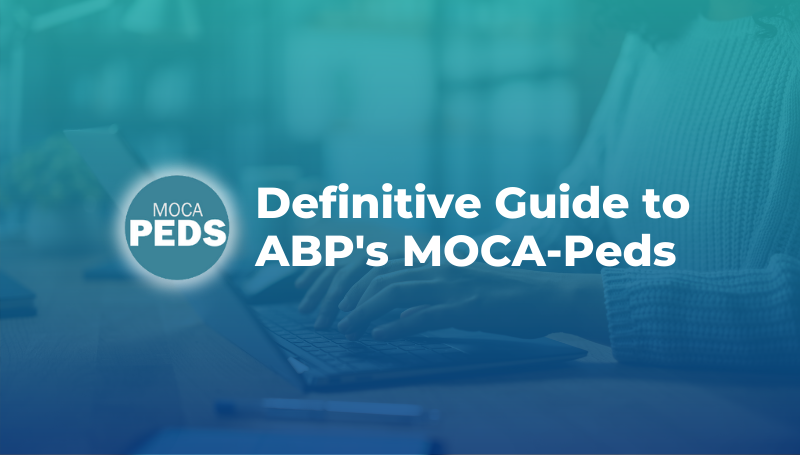
As a pediatrician, you understand the importance of maintaining your board certification for your practice, professional growth, and patient care. The American Board of Pediatrics (ABP) offers a streamlined, flexible way to keep your certification current through the Maintenance of Certification Assessment for Pediatrics, known as MOCA-Peds. This guide will walk you through everything you need to know about MOCA-Peds, covering its history, structure, cost, how to prepare, and more.
Get QuickREF for 2025 MOCA-Peds learning objectives.
MOCA-Peds overview
MOCA-Peds, an online assessment program developed by the ABP, provides an alternative to the traditional 10-year recertification exam. Pediatricians can demonstrate their knowledge and stay up-to-date with medical advancements continuously through this program.
MOCA-Peds offers more flexibility and reduce stress compared to the traditional exam by providing a more integrated approach to maintaining certification.
Historical context and evolution of MOCA-Peds
The ABP introduced the concept of MOCA-Peds as part of a broader effort to modernize the Maintenance of Certification (MOC) process. Before MOCA-Peds, pediatricians had to take a comprehensive exam every 10 years to maintain certification, a process that many found burdensome and anxiety-inducing.
The MOCA-Peds program began as a pilot in 2017 and, due to its success and positive feedback from pediatricians, became a permanent option in 2019. MOCA-Peds reflects the ABP's commitment to supporting lifelong learning and quality improvement in pediatric practice.
How MOCA-Peds differs from the 10-Year recertification exam
Unlike the traditional 10-year recertification exam, which requires extensive preparation and takes place in a secure, proctored environment, MOCA-Peds offers a more flexible, ongoing assessment process. Instead of facing a single high-stakes exam, you’ll receive a series of questions throughout the year, allowing you to complete the assessment at your own pace, in a time and place that you choose.
This continuous approach not only reduces the pressure associated with the 10-year exam but also encourages you to stay engaged with the latest developments in pediatrics.
How MOCA-Peds works
MOCA-Peds operates on a five-year cycle, with each year focusing on a different area of pediatric practice. Every quarter, the program delivers 20 multiple-choice questions through the MOCA-Peds platform, accessible via computer or mobile device. You can answer the questions at any time during the quarter. You will have five minutes allocated per question once you begin.
These questions assess your knowledge and clinical judgment, often including a brief explanation or reference to guide your learning.
While MOCA-Peds is taken on a five-year cycle, it’s important to think about it in year-long increments. Every year the assessment begins again with a new content outline that focuses on learning objectives and featured readings that require your full understanding.
MOCA-Peds exam structure
The MOCA-Peds assessment draws from specific content domains relevant to your subspecialty or general pediatrics. Each year, you’ll encounter questions that cover topics from these domains, ensuring a well-rounded assessment of your knowledge and skills.
The content divides into three main categories:
- Core Knowledge in Pediatrics: Covers general pediatric knowledge that every pediatrician should know.
- Decision-Making and Problem-Solving: Assesses your ability to apply knowledge in clinical scenarios.
- Updates and New Information: Focuses on the latest advancements and updates in pediatrics.
You’ll encounter questions from all three categories each year, ensuring that your knowledge remains broad and current.
How many questions are on MOCA-Peds?
Each year, MOCA-Peds consists of 80 questions, divided into 20 questions per quarter. Over the four-year cycle, you’ll answer a total of 320 questions. This steady flow of questions reinforces learning and alleviates the pressure of cramming for a single exam.
What will MOCA-Peds questions cover?
For General Pediatrics, the assessment questions are based on 45 learning objectives and a handful of featured readings. Each year’s featured readings are based on new guidelines and article developments in the field of pediatrics.
The learning objectives and readings are listed in a new content outline released annually by the ABP. The questions reflect the breadth of knowledge required for pediatric practice from a general pediatrics focus.
There are also content outlines and assessments available and rolling out for a variety of pediatric subspecialties.
How MOCA-Peds is scored
MOCA-Peds tracks your performance over each four-year cycle. Each question carries one point, and your score accumulates based on the number of correct answers you provide throughout the year. Since incorrect answers do not result in penalties, you should answer every question. You will be able to see your raw score throughout the testing cycle.
At the end of each year, the ABP provides you with a performance report, including your total score and how it compares to the passing standard for that year. The passing standard relies on a criterion-referenced process, set according to how well a competent pediatrician should perform on the assessment.
MOCA-Peds passing score
To pass MOCA-Peds, you must meet or exceed the passing standard set by the ABP each year. Pediatricians and psychometric experts determine the passing score through a rigorous standard-setting process, ensuring that those who pass have demonstrated the knowledge and skills necessary for high-quality pediatric practice.
After you submit an answer, you’re told whether you got it right or wrong. You'll also see the rationale behind the correct answer and references to support it. Make sure you take a second look at those questions you thought you knew, but didn't. It's likely that you'll see those questions again. Post-assessment, you should be able to see those on the "My Performance" page.
Once you submit your answers, your performance will be graded by the ABP using a standardized score scale ranging from one to 300 with 180 as the threshold for a passing score.
This is meant to ensure that no one taking the assessment has an advantage or disadvantage by receiving too many easy or difficult questions. You’ll also be able to drop your four lowest scores over the course of the five-year MOC cycle.
If you meet the passing standard each year, you will maintain your certification without the need for additional testing. However, if you fall short, you can improve in subsequent years or opt to take the traditional 10-year exam.
How to prepare for MOCA-Peds
Although MOCA-Peds in an open-book assessment, the 5-minute window to answer questions can go by quickly. MedStudy developed a QuickREF guide that is specific to the MOCA-Peds exam. You can use QuickREF to read through learning objectives ahead of the exam, and use it as your open-book resource while you answer questions. It has a detailed table of contents that makes finding the Learning Objectives simple and quick.
You can also use QuickREF in digital format to search by keyword. We hear from many Pediatricians who've taken MOCA-Peds that they'll pull the testing window up in one browser on their screen, and pull digital QuickREF into another. Then they search specific keywords from the question, and can see every place that keyword is within QuickREF. It makes it simple to find information fast during the answering window.
If you want to prepare ahead of time, try using MedStudy's Pediatric Qbank+ to set up timed practice exams. There is a MOCA-Peds filter so you can set up qbank sessions with questions that are specific to MOCA-Peds learning objectives and featured readings.
Who should take MOCA-Peds?
MOCA-Peds offers an excellent option for pediatricians who prefer a flexible, ongoing assessment process over the traditional 10-year exam. It suits those who value continuous learning and want to stay engaged with current pediatric practices.
If you feel comfortable with online assessments and prefer to avoid the stress of a high-stakes exam, MOCA-Peds may be the right choice for you. It’s also a good fit if you prefer to study and learn in smaller, more manageable increments rather than preparing for a single, comprehensive exam.
How much MOCA-Peds costs
The cost of MOCA-Peds is covered in your annual MOC fee paid to the ABP.
MOCA-Peds represents a significant shift in the way pediatricians maintain their board certification. MOCA-Peds aligns with the realities of modern pediatric practice and the need for lifelong learning. If your recertification date approaches, consider MOCA-Peds as a practical, less stressful alternative to the traditional 10-year exam.
With the right preparation and resources, you can confidently navigate MOCA-Peds and continue providing high-quality care to your patients while maintaining your certification.


